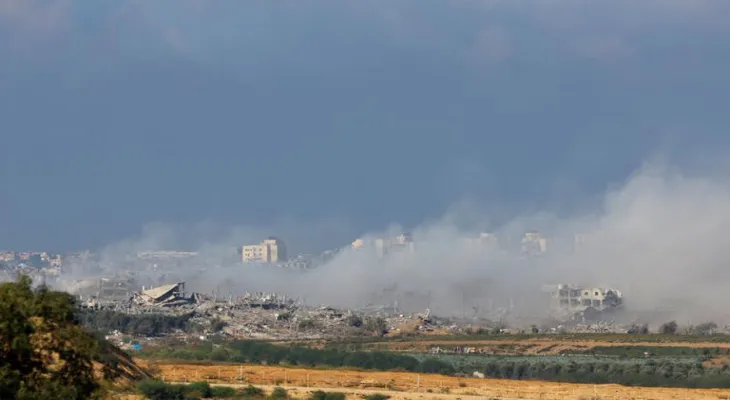Search here
Newspaper
Search here

Arab Canada News
News

Published: November 16, 2023
Israel ordered civilians to leave four towns in the southern part of the Gaza Strip on Thursday, increasing fears of its war against Hamas expanding to areas previously declared safe for people to move to.
In the northern Gaza Strip, Israel said its forces were still present at the Al-Shifa medical complex but did not provide any details about operations there since Wednesday, when the forces stormed the complex after besieging it for days.
Reuters was unable to verify conditions at the hospital on Thursday morning after losing contact with doctors inside since Wednesday.
Leaflets dropped by an Israeli aircraft overnight ordered civilians to leave Khaza'a, Abasan, Bani Suhaila, and Al-Qarara on the eastern outskirts of Khan Yunis city in the southern Gaza Strip. These towns are home to more than 100,000 people in peacetime but currently shelter tens of thousands of additional people who fled from other areas.
The leaflets said the Israeli army would deal with Hamas's actions in the mentioned residential areas and added, "For your safety, you must immediately evacuate your homes and head to known shelters... Anyone who approaches terrorists or their facilities endangers their life, and every house used by terrorists will be targeted." Residents said the area was already heavily bombed overnight.
Israel had already ordered the evacuation of the entire northern half of the Gaza Strip before ground troops entered it late last month. Residents walk in long lines carrying few belongings daily heading south, passing Israeli soldiers during "tactical pauses" of six hours to allow people to leave.
The United Nations says about two-thirds of the Gaza Strip's 2.3 million population are displaced, most taking refuge in towns in the southern Gaza Strip.
Israel launched its campaign against Hamas, which runs the Gaza Strip, after the group attacked southern Israel on October 7. Israel says 1,200 were killed and about 240 held captive.
Since then, Israel has tightened its siege on the Strip by cutting food and fuel, conducting airstrikes, and ground incursions which Palestinian authorities say, in statements the UN considers reliable, have killed more than 11,500 people, about 40 percent of them children, while many casualties remain under the rubble.
It has become impossible to confirm conditions on the second day of the Israeli operation at Al-Shifa hospital with communications cut off since Wednesday afternoon.
The ordeal at the hospital has raised international concern with hundreds of patients and thousands of displaced civilians trapped inside without fuel, oxygen, or essential supplies.
Paramedics said dozens of patients died in recent days due to the Israeli siege, including three newborn infants in incubators that lost function due to electricity cuts.
After a day of entering Al-Shifa hospital, Israel has yet to provide evidence supporting its claim that it is a large Hamas headquarters in a tunnel network beneath the facility, which it said justifies considering the hospital a military target.
Israel released a video showing a soldier walking through a hospital building displaying bags containing firearms and bulletproof vests it said were found hidden there, in addition to other rifles in a closet and a laptop.
Kenneth Roth, a former Human Rights Watch director and current visiting professor at Princeton, said on X social platform, "Israel will have to provide much more than a few light rifles to justify shutting down hospitals in northern Gaza, with the terrible cost this entails for civilians who have urgent medical needs."
Hamas said the video was fabricated. Other Palestinians said even the video did not show anything resembling what Israel called a large military headquarters under the hospital.
Dr. Nahid Abu Tuma, director of Nasser Hospital in Khan Yunis, said those justifications are weak, noting that the "resistance" has nothing inside any medical facility, and said paramedics and medical staff are worried about their colleagues in Al-Shifa after losing contact with them since Wednesday.
He continued saying Israelis claimed there were command centers at Al-Shifa, and when they couldn't find anything, they stood "ashamed" before the world, adding that this pushed them to search for "excuses" for the falsehoods they previously published.
He said he is deeply worried about his colleagues and patients at Al-Shifa because they are exposed to "imminent danger." He stated the smell of death is everywhere with the bodies of "martyrs" scattered in the courtyard without anyone to bury them.
The fate of the Gaza Strip after the war is also a focus. Israeli President Isaac Herzog said Israel would have to maintain a "strong force" in Gaza in the near future to prevent Hamas from re-emerging in the Strip after the war, but U.S. President Joe Biden warned that occupying the Strip would be a "big mistake."
Herzog said in an interview with the Financial Times on Thursday, "If we withdraw, who will take responsibility? We cannot leave a vacuum. We have to think about what the mechanism will be. Many ideas are being proposed... but no one wants this place, Gaza, to become a base for terrorism again."
Herzog added to the paper that the Israeli government is discussing many ideas about how to manage the Gaza Strip once the war ends, noting that the United States and "our neighbors in the region" are supposed to have some participation in the system that will be established after the conflict period.
Biden said on Wednesday that he made it clear to Israeli Prime Minister Benjamin Netanyahu that a two-state solution is the only way to settle the Israeli-Palestinian conflict and that occupying Gaza would be a "big mistake."
The Palestinian Authority says the Gaza Strip, which has been run by Hamas since 2007, is an integral part of the future Palestinian state.
Comments